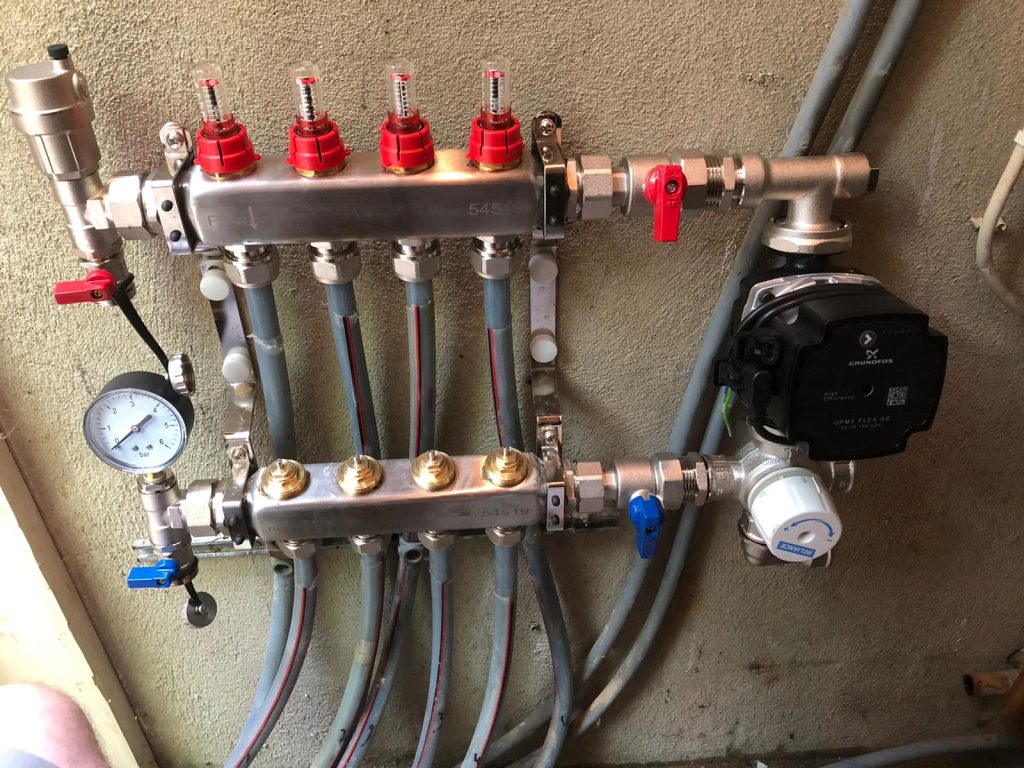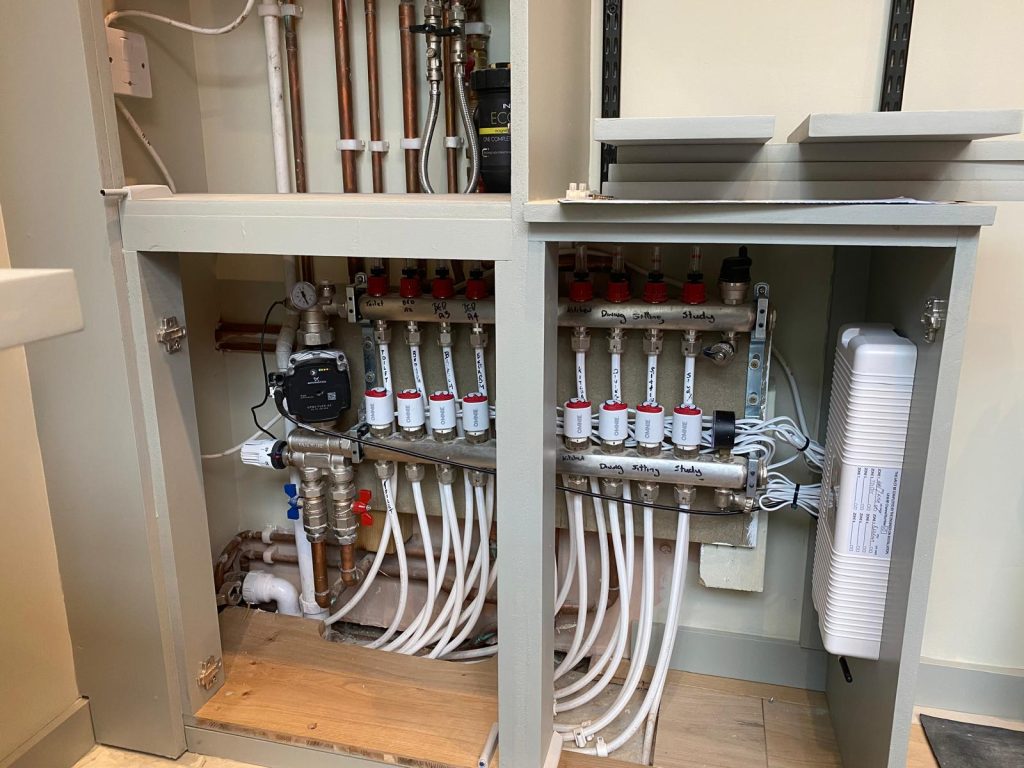Underfloor heating (UFH) has become an increasingly popular choice for homeowners in Edinburgh seeking efficient, low-profile, and comfortable heating. Whether installed in a modern flat, a Victorian tenement, or a basement conversion, UFH systems can add convenience and value.
However, as with any home heating technology, underfloor systems don’t last forever. If you’re experiencing faults—such as cold spots, unresponsive thermostats, leaks, or increased running costs—you may be wondering whether to repair or replace your underfloor heating.
This guide will help you understand the factors that go into that decision, particularly in the context of Edinburgh’s unique housing stock, climate, and property regulations.
Understanding Your Underfloor Heating System
Before deciding whether to repair or replace, it’s essential to know what type of system you have. In Edinburgh, the most common types are:
- Electric underfloor heating (dry systems): These consist of heating cables or mats installed under the floor surface and connected to mains electricity. They’re often used in smaller areas like bathrooms, kitchens, or converted basements.
- Water underfloor heating (wet systems): These use pipes to circulate warm water beneath the floor, usually connected to a boiler or heat pump. They are common in extensions, new-builds, or whole-floor retrofits.
Each system has different lifespans, costs, and repair needs. Understanding the system’s design and age is key to evaluating whether repairs are cost-effective.

Common Issues with Older UFH Systems
In many Edinburgh homes, underfloor heating was installed 10–20 years ago as a premium upgrade. While some systems continue to perform well, others may start to show signs of wear. Common issues include:
- Uneven or inconsistent heat distribution
- Thermostats or sensors not responding
- Electric mats or wires becoming damaged
- Leaks in wet systems
- Airlocks or blockages
- Increased energy bills
- Poor floor insulation leading to inefficiency
Not all faults require a full replacement—but some may not be worth repairing depending on the cost, performance, and age of the system.
When Repair Makes Sense
Repairing an underfloor heating system is often the more economical and less disruptive option—particularly if the issue is isolated or the system is relatively modern. Situations where repair is a sensible choice include:
1. Minor Thermostat or Control Faults
Many issues stem from a faulty or outdated thermostat. In such cases, replacing or recalibrating the controller is inexpensive and minimally invasive. Upgrading to a modern smart thermostat can also improve efficiency.
2. Airlocks or Flow Problems in Wet Systems
If certain areas are not heating due to air trapped in the system or low water pressure, bleeding the system and rebalancing zones can resolve the problem without major work.
3. Damaged Manifold Components
Manifolds can wear over time, especially if not serviced regularly. Replacing faulty pumps, actuators, or valves is relatively straightforward and much cheaper than a full system replacement.
4. Flooring Is in Good Condition
If your floor finish is high-quality, difficult to replace, or original to the property (e.g. in an Edinburgh listed building), repairs can be done without removing the entire floor—especially for wet systems where access to the manifold is sufficient.
When Replacement Might Be the Better Option
In some cases, repairing an underfloor heating system is not cost-effective or even possible. Here’s when a full replacement may be the right choice:
1. System Age and Obsolescence
Most electric systems have a lifespan of around 15–20 years, and wet systems can last up to 50 with proper maintenance. However, if your system is over 15 years old and showing repeated faults, replacement may be more economical in the long term.
2. Repeated Failures or Multiple Zones Affected
If you’ve already repaired one or more areas and faults continue to emerge across zones, this may suggest a wider system issue. This is especially common with electric mats under tiled floors that have cracked or been damaged.
3. Poor Original Installation
Some earlier installations in Edinburgh homes were carried out without adequate insulation, spacing, or zoning. If your system was never efficient to begin with, a replacement can vastly improve comfort and running costs.
4. Major Renovation or Flooring Upgrade
If you’re already planning to replace the flooring—such as removing tiles or carpet—this is the ideal opportunity to upgrade the UFH system too. New systems offer better efficiency, quicker heat-up times, and are compatible with smart controls.
Costs: Repair vs Replacement
The cost difference between repair and replacement can be significant. Here’s a rough comparison based on average figures for a 20m² area in Edinburgh:
| Service | Estimated Cost (incl. VAT) |
| Thermostat replacement | £120–£250 |
| Manifold pump replacement | £200–£350 |
| Electric mat section repair | £250–£500 |
| Full electric system replacement | £1,000–£1,500 |
| Full wet system replacement | £2,500–£4,500+ |
| Smart control upgrade | £200–£500 per zone |
Always consider long-term savings when comparing these costs. A newer system may cut your energy bills and increase property value—particularly in competitive Edinburgh neighbourhoods like Morningside, Leith, or the New Town.
Energy Efficiency Considerations
A major benefit of replacing older UFH systems is improved energy efficiency. Modern underfloor heating systems use lower temperatures to produce the same warmth, and better controls allow zoning by room.
If you’re also upgrading your boiler or switching to a heat pump, compatibility with newer UFH pipework can make a big difference. Heat pumps work best with low-temperature systems like underfloor heating, which means improved savings and reduced carbon footprint.
Many Edinburgh homeowners are also taking advantage of smart meters and energy-saving grants—replacing inefficient UFH helps you get the most out of these.

Heritage and Listed Property Challenges
Edinburgh is home to thousands of listed buildings, especially in the New Town, Old Town, and Marchmont areas. Retrofitting or replacing UFH in these properties can be challenging due to:
- Protected floor finishes (e.g. original timber or stone)
- Restrictions on altering subfloors
- Difficulty running new pipework or wiring
In such cases, replacement may be limited to specific rooms or must be done using reversible methods. Repairs may be the more viable route if your system is mostly intact. Always consult your local authority for guidance on listed building consent.
Environmental and Financial Incentives
Replacing an older underfloor heating system can also open up access to grants and incentives, such as:
- The Boiler Upgrade Scheme (BUS) for installing heat pump-compatible wet systems
- Energy Company Obligation (ECO) schemes for improving insulation and heating
- Green mortgages or low-interest loans for energy-efficient renovations
If your old system is contributing to high carbon emissions or inflated bills, a replacement aligned with these schemes can offer long-term value—especially in energy-conscious cities like Edinburgh.
Questions to Ask Before Making a Decision
To help decide between repair and replacement, ask yourself:
- How old is the system, and has it been maintained?
- Is the fault isolated or recurring?
- Are you planning a renovation or flooring upgrade anyway?
- Are parts still available for your current system?
- Will a new system offer significantly better efficiency?
- Do you plan to stay in the property long-term?
The Verdict: Repair or Replace?
In most cases, if your underfloor heating system is under 10–15 years old and the fault is limited, repair is the smarter, more cost-effective choice. Problems with thermostats, valves, or isolated zones can usually be addressed without major disruption.
However, if the system is ageing, poorly performing, or you’re already carrying out a major renovation, replacement will provide better long-term comfort, efficiency, and property value.
For homeowners in Edinburgh—where property values are high and the climate makes reliable heating essential—investing in an efficient, well-designed underfloor heating system is usually money well spent.
Final Thoughts
Whether you live in a Georgian flat in Stockbridge, a sandstone semi in Blackhall, or a modern apartment in Leith, underfloor heating can bring added comfort and value to your home. But when problems arise, it’s important to weigh up the costs, disruption, and benefits of repair versus replacement.
The key is to act early. Ignoring a small fault can lead to bigger problems—and higher costs—down the line. Consult a qualified underfloor heating engineer familiar with Edinburgh’s property types to assess your system and recommend the best path forward.
A warm floor in winter isn’t just a luxury in Edinburgh—it’s a comfort you deserve, and an investment in your home’s future.
